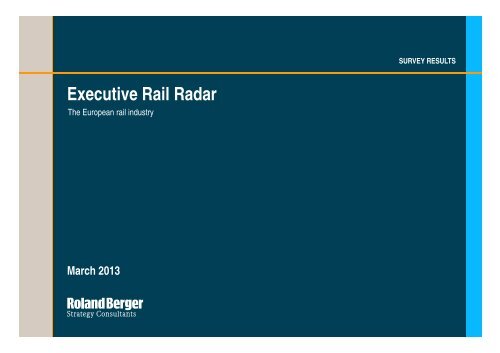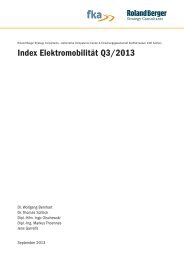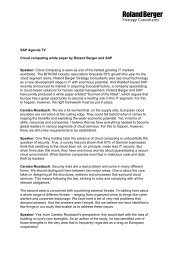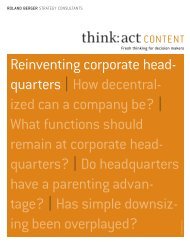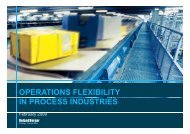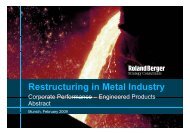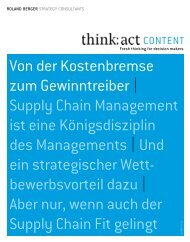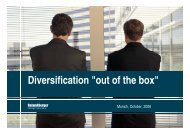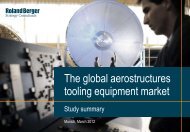Executive Rail Radar - The European rail industry - Roland Berger
Executive Rail Radar - The European rail industry - Roland Berger
Executive Rail Radar - The European rail industry - Roland Berger
- No tags were found...
Create successful ePaper yourself
Turn your PDF publications into a flip-book with our unique Google optimized e-Paper software.
SURVEY RESULTS<strong>Executive</strong> <strong>Rail</strong> <strong>Radar</strong><strong>The</strong> <strong>European</strong> <strong>rail</strong> <strong>industry</strong>March 2013
<strong>The</strong> new <strong>Executive</strong> <strong>Rail</strong> <strong>Radar</strong> presents key insights into the <strong>rail</strong><strong>industry</strong> – We look forward to discussing the results with youBACKGROUND ANDINTRODUCTION> In 2011, we conducted and published the first <strong>Executive</strong><strong>Rail</strong> <strong>Radar</strong> to support <strong>industry</strong> leaders in identifying keyissues that drive their <strong>industry</strong>, and to promote executivelevelthinking in the <strong>European</strong> <strong>rail</strong> <strong>industry</strong>> As a top strategy consultancy in the <strong>rail</strong> sector and othertransportation <strong>industry</strong> segments, we aim at regularlyproviding fresh insights into the <strong>rail</strong> <strong>industry</strong>'s current andmost important issues> We have therefore put together a second <strong>Executive</strong> <strong>Rail</strong><strong>Radar</strong>, capturing opinions and responses on the key <strong>rail</strong><strong>industry</strong> topics> Here, we present the key findings and conclusions, andtrust you will find them insightful in supporting yourstrategic thinking and decision making. We would welcomethe opportunity to have a more detailed discussion withyou on any of the issues presentedTHE EUROPEAN RAIL PRACTICEMANAGEMENT TEAMDidier BréchemierFrancesco Calvi ParisettiJorge DelclauxFriedrich DemmerAlain d'Oultremont<strong>Roland</strong> FalbPedro GalhardasMaria MikhaylenkoAndreas SchwillingRené SeygerMartin Streichfuss<strong>Roland</strong> Zsilinszky(Paris)(Milan)(Madrid)(London)(Brussels)(Vienna)(Lisbon)(Moscow)(Munich)(Amsterdam)(Düsseldorf)(Prague)2
<strong>The</strong> results are based on contributions from senior executivesacross the <strong>European</strong> <strong>rail</strong> <strong>industry</strong>PROFILE OF RESPONDENTSPARTICIPATING COMPANIES> <strong>The</strong> responses to the <strong>Rail</strong> <strong>Radar</strong> survey are wellbalanced in terms of participating countries: Austria,Belgium, Czech Republic, Denmark, France,Germany, Italy, the Netherlands, Romania, Russia,Slovak Republic, Slovenia, Switzerland and theUnited Kingdom> In addition, different <strong>rail</strong> segments are represented inthe survey: 45% of responses are from integrated<strong>rail</strong>ways and 24% from municipal transport firms. <strong>The</strong>remaining survey participants are from train operatingcompanies (17%), <strong>rail</strong> infrastructure providers (9%)and other segments (5%)> Almost two-thirds of the responses were provided byexecutives at top management level, 16% came fromCxO level> <strong>The</strong> online survey was conducted between Novemberand December 20123
<strong>The</strong> survey yields key topics on <strong>rail</strong> executives' agendas for 2013and details selected broader <strong>industry</strong> issuesAGENDA 2013> Topics at the top of <strong>rail</strong>executives' agendasin 2013> Key changes versusprevious surveyInnovationFlexibility, efficiencyProfitability, stabilityGrowth and expansionAssetmanagementHR managementQualityFinancingSELECTED KEYISSUES IN FOCUS> Detailing of selectedbroader <strong>industry</strong> issues:– Planning process– EU <strong>rail</strong> legislation– Financing– HomologationPlanning processesEU legislationPublic privatepartnershipsHomologation, TSIProximity of topics to the center indicates importance4
<strong>Executive</strong> summary (1/2)COMPANY'S AGENDASIN 2013COMPLEXITY INCORPORATE PLANNINGRECENTDEVELOPMENTS IN(DE)REGULATION> Profitability and financial stability remain at the top of <strong>rail</strong> executives' agendas thisyear, financing and asset management are subsequent priorities – All of these topicsbecame even more important since the previous survey conducted in 2011> Quality enhancement lost importance since 2011, but is still high on the agenda> Innovation and HR management grew strongly in importance> Cost cutting/efficiency programs will be continued, extended or newly set up in 2013> <strong>The</strong> importance of planning is showing a tendency to rise, while a broader scope andshort-term nature are increasing planning complexity> Budgeting is considered as being the most complex planning process> To reduce planning complexity, <strong>rail</strong> companies avoid details, rely on past experienceand reduce output parameters and forecasting periods> <strong>The</strong> recast of the first <strong>rail</strong>way package is viewed very critically by <strong>rail</strong> executives –More than 40% even expect adverse effects, considering it too regulated> All individual key rules of the recast are supported by (often far) less than 30%> Although <strong>rail</strong> executives support the stricter control of track access charges ingeneral, they are opposed to the recast's infrastructure charging rules> In 2013, <strong>rail</strong>ways will keep up intensive interaction with EU officials on the futuredevelopment of EU <strong>rail</strong> legislation5
<strong>Executive</strong> summary (2/2)FINANCING OFRAILWAYS ANDMUNICIPAL TRANSPORTHOMOLOGATION ANDITS EFFECTS1) Technical Specifications for interoperability> <strong>Rail</strong> executives aim at internal sources of financing infrastructure/operations throughefficiency and revenue enhancements. However, the need for public funding remains> As today, public-private partnerships (PPP) are considered to play an important rolein municipal transport, rather than for <strong>rail</strong>way financing> PPPs are seen as both a blessing and a curse: Additional efficiency pressure andcultural change are appreciated, while the profitability expectations of privateinvestors are seen as a key disadvantage at the same time> <strong>Rail</strong>way stations and primary infrastructure of individual lines are considered to bemost suitable for PPP investments in infrastructure> Functional privatization via dedicated service contracts is expected to prevail overother forms of privatization, material privatization with asset ownership is seen as anexception> <strong>The</strong> vast majority of <strong>rail</strong> executives considers homologation procedures lengthy,often problematic> Lack of efficiency is viewed as a similar problem in <strong>European</strong> countries, whereasother industries are considered to be more efficient in homologation> <strong>European</strong> initiatives for TSIs are generally appreciated by <strong>rail</strong> executives. However,faster and more intensive implementation is demanded for 20136
TOPICSa. COMPANIES' AGENDAS IN 2013:Profitability and financial sustainability are top priorityb. COMPLEXITY IN PLANNING:Importance and complexity of planning are risingc. RECENT DEVELOPMENTS IN (DE)REGULATION:Recast of first <strong>rail</strong>way package viewed very criticallyd. FINANCING OF RAILWAYS AND MUNICIPALTRANSPORT:Internal and public financing preferred over PPPe. HOMOLOGATION AND ITS EFFECTS:Procedures lengthy, other industries more efficientf. YOUR CONTACTS AT ROLAND BERGER:We will be happy to discuss the results with you7
a. Companies' agendas in 2013Profitability/efficiency, financing and asset modernization dominate<strong>rail</strong> companies' agendas in 2013 – Broad variety of specific topicsTOP TOPICS ON COMPANY'S AGENDAS IN 2012-13 1)12345678910Profitability, financial stabilityFinancing (investment,public service obligations)Quality improvementModernizing infrastructureGrowthInnovation, innovativeservice offeringsImproving flexibility, efficiencyGeographic expansionModernizing rolling stockHR management and development1) % of mentioning as one of the top 3 topics in a list of 20 topics15%13%13%22%20%19%19%28%26%56%> Profitability issues are ahead of other topics on <strong>rail</strong>companies' agendas in 2013; cost cuttingprograms will be continued, extended or newly setup, networks and offers might be reviewed> In addition, two topics relatively specific to the <strong>rail</strong><strong>industry</strong> come in second and third, i.e. financingand modernizing infrastructure, indicating impactfrom the <strong>European</strong> debt crisis and financingconcerns> Growth and innovations are fifth and sixth,indicating room for expansion, top line andservice-related topics> Overall, a great variety of topics was noted by thesurvey participants as being important in 2013,incl. sustainability, specific contracts, ERTMSdeployment or safety issues> <strong>The</strong> ranking of top topics is fairly similar acrosscountries and company typesSource: <strong>Roland</strong> <strong>Berger</strong> <strong>Executive</strong> <strong>Rail</strong> <strong>Radar</strong>8
a. Companies' agendas in 2013Profitability, financing, asset and HR management gained importanceversus 2011– Quality and growth lost, but are still in the top 5CHANGES IN TOP 10 TOPICSVERSUS 2011 SURVEYRank ∆ rank2012 vs. 2011 Topic ∆ score vs. 2011 1)12345678± 0+5-1+2-2+9-2± 0Profitability, financial stabilityFinancing (investment,public service obligations)Quality improvementModernizing infrastructureGrowthInnovation, innovativeservice offeringsImproving flexibility, efficiencyGeographic expansion-15%-17%0%0%5%4%8%11%> In 2011, we conducted and publishedthe first <strong>Executive</strong> <strong>Rail</strong> <strong>Radar</strong>, askingthe same question on the top topics oncompanies' agendas> Profitability was considered the mostimportant topic in 2011 and has gainedeven greater importance since then> Asset management (infrastructure,rolling stock), financing, innovation andHR management gained strongly inimportance9 +1Modernizing rolling stock2%10 +8HR mgmt. and development9%1) ∆ %-pts. of mentioning in top 3 topics in a list of 20 topicsSource: <strong>Roland</strong> <strong>Berger</strong> <strong>Executive</strong> <strong>Rail</strong> <strong>Radar</strong>9
. Complexity in planning<strong>The</strong> importance of planning has tended to rise, while a broaderscope and a short-term nature are increasing planning complexityIMPORTANCE OF PLANNING 1)Planning becomes more important,more complex environmentPlanning is intensified, more variables,inputs, parameters, etc.Scenario-based approach,uncertainties in environmentImportance unchanged,reaction times more importantShorter planning periods,more frequent changesOther 9%11%38%36%36%32%> <strong>The</strong> <strong>rail</strong> environment is becoming increasinglyimportant, complex and short-term oriented> This has to be mapped in planning processes– Planning is intensified– Planning systems are made more flexible,aiming to cope with short-term changes> Consequently, the planning itself becomes morecomplex> As efficiency/profitability is high on companies'agendas, <strong>rail</strong> companies must – despite the highlycomplex environment – aim to reduce this complexityin planning processesNo change in importanceof planning6%1) % of answers; multiple answers possibleSource: <strong>Roland</strong> <strong>Berger</strong> <strong>Executive</strong> <strong>Rail</strong> <strong>Radar</strong>10
. Complexity in planning<strong>The</strong> planning of budgets and demand forecasts are consideredparticularly complex issuesMOST COMPLEX PLANNING PROCESS 1)Yield andrevenueplanningCapacity planning14%19%13%Passenger/cargo forecastOther1%21%31%Annual budgetLong-term budget(e.g. 5-year period)> More than half of <strong>rail</strong> executives consider processesfor long and short-term budgeting the mostcomplex issues in planning. Especially here,complexity should be reduced> Passenger demand forecasts are fairly simple onan overall level. However, on a route, day and timebasis it becomes quite complex> Although revenue management has beenintroduced by many <strong>European</strong> passenger <strong>rail</strong>ways(DB, SNCF, SJ, Eurostar, Thalys and many more),only one in seven <strong>rail</strong> executives considers the topline to be the most complex item in planning> Some <strong>rail</strong> executives note that public financingcan add complexity to any respective planning> <strong>Rail</strong> companies might decide to work on theirbudgeting processes, making them more efficient1) % of mentioning as top 1 topicSource: <strong>Roland</strong> <strong>Berger</strong> <strong>Executive</strong> <strong>Rail</strong> <strong>Radar</strong>11
. Complexity in planningTo reduce planning complexity, <strong>rail</strong> companies avoid details, rely onpast experience, and reduce parameters and forecasting periodsMEASURES TO REDUCE COMPLEXITY 1)Focus on flexible response,rather than detailsExtrapolate on basisof previous figuresReduce planningparameters (output)34%45%45%> As we have seen above, <strong>rail</strong> companies mustoffset the increasing complexity in planningprocesses> In particular, they acknowledge that theenvironment and planning assumptions canchange quickly so that flexible reactions becomemore important than detailed planningReduce forecastperiodsReduce inputs 15%Use a randombasedapproach4%Other 4%17%> <strong>The</strong> extrapolation of previous figures is seen as anequally important way to reduce complexity – Foroverall figures this is often fine, on a more detailedlevel this appears to be a critical/dangerousapproach> Furthermore, <strong>rail</strong> companies also reduce outputparameters, forecasting periods and inputvariables1) % of answers; multiple answers possibleSource: <strong>Roland</strong> <strong>Berger</strong> <strong>Executive</strong> <strong>Rail</strong> <strong>Radar</strong>12
c. Recent developments in (de)regulationMore than 40% of respondents criticize the recast as too much regulation,36% consider it a good compromise, 17% think it is late/softOPINIONS ON THE RECAST OF THE FIRST EURAILWAY PACKAGETOTAL SURVEYAll 43% 36% 17% 4%BY SEGMENTIntegrated <strong>rail</strong>way 63% 29% 4%Train operating company 50% 33%<strong>Rail</strong> infrastructure 25% 25%50%17%Municipal transport 10% 40% 40% 10%Regulates too much,adverse effectsGood compromise betweenstakeholders in <strong>rail</strong>way transportComes too late,stricter rules requiredOther1) <strong>The</strong> LIB Index shows the relative status of liberalization of the <strong>rail</strong> transport markets in Europe.<strong>The</strong> respective study is conducted regularly by Prof. Kirchner/Humboldt University Berlin and IBMSource: <strong>Roland</strong> <strong>Berger</strong> <strong>Executive</strong> <strong>Rail</strong> <strong>Radar</strong>4%> Recast in general viewed critically; especiallyexecutives in Germany, Switzerland, Denmark,Slovakia and Slovenia expect the recast to have anegative impact> As expected, executives from train operatingcompanies and separated infrastructure operatorshave a more positive opinion on the recast thanthose from integrated <strong>rail</strong>ways> However, 25% of executives from <strong>rail</strong> infrastructurecompanies consider regulation too strictand expect negative impacts> 17% of the executives think that the recast comestoo late and should be stricter. Unsurprisingly,nobody from an integrated <strong>rail</strong>way shares thisopinion> Interestingly, countries that are advanced inliberalization (according to LIB Index 1) ) view therecast especially critically13
c. Recent developments in (de)regulationStricter regulation is in general viewed rather critically – Strictercontrol of track access charges receives the broadest supportAREAS FOR STRICTER REGULATION 1)Stricter control oftrack access chargesSeparate legal entitiesfor <strong>rail</strong>-related facilitiesSeparate infrastructure fromtrain operatorsNo profit transfersallowedETCS-differentiatedtrack chargingOther 7%1) % of answers; multiple answers possibleSource: <strong>Roland</strong> <strong>Berger</strong> <strong>Executive</strong> <strong>Rail</strong> <strong>Radar</strong>12%21%21%26%50%> None of the specified rules is supported by morethan 50% of <strong>rail</strong> executives> Stricter control of track access charges receives thehighest support– Interestingly, here the support from integrated<strong>rail</strong>ways is significantly higher than from trainoperating companies and infrastructure providers– Note that <strong>rail</strong> executives oppose the infrastructurecharging rules as formulated in the recast> Only 21% of <strong>rail</strong> executives support legal action forstronger separation from train operators – Thisdoes not exceed 50% among infrastructureoperators> Other areas mentioned are independent accessregulation and stricter control of funding authoritiesand regulating bodies> Comparably broad support for stricter rules comesfor instance from France and Slovakia – Lowsupport from Czech Republic and Switzerland15
d. Financing of <strong>rail</strong>ways and municipal transport<strong>Rail</strong>ways consider internal sources of finance crucial, in particularproductivity gains – PPPs more important for municipal transportOPINIONS ON MAIN LEVERS FOR FINANCING 1)ALL SECTORSMUNICIPAL TRANSPORTImproved efficiency andproductivity of <strong>rail</strong>waysPublic financing81%60%90%90%> <strong>Rail</strong> companies emphasize sourcesthey can influence themselves, i.e.productivity gains and additionalrevenuesPrice increasesat <strong>rail</strong>ways42%50%> Public financing remains among thetop financing sources for <strong>rail</strong>waysAdditional revenues,e.g. in stationsRedesign networkIncrease pricedifferentiationPPPs40%35%21%16%20%30%50%60%> This can be interpreted as a reactionto insecure or even reduced publicfunding due the <strong>European</strong> debtcrisis, i.e. as <strong>rail</strong>ways shift financingoptions to internal sources> PPPs come in last in total surveyresponses, but have a much higherimportance for municipal transport1) Financing of infrastructure projects and transport operations; % of mentioning in top 3Source: <strong>Roland</strong> <strong>Berger</strong> <strong>Executive</strong> <strong>Rail</strong> <strong>Radar</strong>16
d. Financing of <strong>rail</strong>ways and municipal transportPPPs will gain importance and will be significant for developingcountries, but public financing will prevail as the dominant sourceIMPORTANCE OF PPPs IN THE NEXT FIVE YEARS 1)PPPs will not fill the gap,although public financingwill be reducedPublic financing will remainthe dominant financingmode for <strong>rail</strong>waysPPP will be importantfor developing countriesPPPs will be a unique formof financing worldwidePPPs will become a majorfinancing mode in Europe, too5%5%Other 5%1) Financing of infrastructure projects and transport operations;% of answers; multiple answers possible31%40%60%> <strong>The</strong> responses point to a relatively critical attitudeon the part of <strong>rail</strong>way companies to PPPs; <strong>rail</strong>waysassume that PPPs will not be big enough tocompensate for potential financing gaps frompublic sources> Potential reasons might be insufficient experiencewith PPPs and hence reservations, lack of accessto PPPs, or structural reasons (PPPs not suited forgeneral or long-term financing, rather for specificpurposes)> Another reason is that respondents expect PPPsto better suit specific projects, e.g. stations orindividual lines, i.e. where revenues and cost canbe directly allocated to the project> Only 5% of respondents expect PPPs to become amajor source of financing in Europe. <strong>The</strong> 60%majority expects PPPs not to fill the publicfinancing gapSource: <strong>Roland</strong> <strong>Berger</strong> <strong>Executive</strong> <strong>Rail</strong> <strong>Radar</strong>17
d. Financing of <strong>rail</strong>ways and municipal transportPPPs considered both a blessing and a curse: Pressure and culturalchange appreciated, while expectations of private investors feared+ MAIN ADVANTAGES 1)MAIN DISADVANTAGES OF PPPs 1) –Additionalfunding95%Pressure byprivateinvestors57%Culturalchange tobusinesscultureRisktransfer51% 46%Complexstructures,contracts,controlmechanisms98%Higher returnexpectationsfrom privateinvestors93%Not suitedfor <strong>rail</strong> transport,publicfinancingneeded60%Publicauthoritieslosecontrol48%> <strong>The</strong> key advantage of PPPs is the additional sourceof funding> Structural PPP items are a further key advantage:Move towards stronger business and privateeconomy orientation1) % of mentioning in top 31) % of mentioning in top 3Source: <strong>Roland</strong> <strong>Berger</strong> <strong>Executive</strong> <strong>Rail</strong> <strong>Radar</strong>> Almost all <strong>rail</strong> executives consider additionalcomplexity to be one of the top 3 disadvantages> <strong>Rail</strong> executives fear higher return expectations, thisview is shared by integrated <strong>rail</strong>ways, infrastructureoperators, train operating companies and municipaltransport alike18
d. Financing of <strong>rail</strong>ways and municipal transport<strong>Rail</strong>way stations and primary infrastructure of individual lines areconsidered to be most suitable for PPP infrastructure investmentsINVESTMENT NEEDS SUITED FOR FINANCINGINFRASTRUCTURE THROUGH PPP 1)<strong>Rail</strong>way stations 63%Primary infrastructureof individual linesPrimary infrastructureof entire (sub)networksSecondary infrastructureOther1) % of answers; multiple answers possible8%15%28%55%> Almost 2/3 of <strong>rail</strong> executives consider <strong>rail</strong>waystations as suitable for PPP investments> More than half of <strong>rail</strong> executives believe thatprimary infrastructure of individual lines (e.g.airport connections, high-speed routes, cargoroutes) can be financed through PPPs> Only a limited number of <strong>rail</strong> executives canimagine financing primary infrastructure of anentire (sub)network or secondary infrastructure(embankments, bridges, tunnels) in this way> Other investments suitable for PPP include carparking and cargo terminals> Earlier, we have seen that profit expectations ofprivate investors are viewed as the most importantdisadvantage of PPPs – Hence, <strong>rail</strong>way stationsappear to be a rather profitable investment onaverage. Additionally, revenues and cost arecomparably easy to attribute to <strong>rail</strong>way stationsSource: <strong>Roland</strong> <strong>Berger</strong> <strong>Executive</strong> <strong>Rail</strong> <strong>Radar</strong>19
d. Financing of <strong>rail</strong>ways and municipal transportIn PPPs, functional privatization (dedicated service contract) isexpected to prevail over other forms of privatizationDEGREE OF PRIVATIZATION LIKELY TO PREVAIL INFUTURE PPPs FOR RAIL FINANCING 1)Material privatization(permanent ownershiptransfer)22%Functionalprivatizationwith temporaryownership transfer22%57%Purely functionalprivatization(no ownershiptransfer)> <strong>The</strong> majority of <strong>rail</strong> executives expects purelyfunctional privatization to prevail in the future:Partnership via service contract, e.g. for designing,building, operating and/or maintaining, withoutasset transfer> Less than half of <strong>rail</strong> executives forecast at leasttemporary asset transfer, less than 1/4 envisagematerial privatization prevailing (permanenttransfer of ownership)> <strong>The</strong> result reflects the timescale that differentstakeholders foresee for a PPP investment– Private investors have short/medium-termexpectations– Public authorities take a medium/long-terminterest1) % of answersSource: <strong>Roland</strong> <strong>Berger</strong> <strong>Executive</strong> <strong>Rail</strong> <strong>Radar</strong>20
e. Homologation and its effectsHomologation procedures are considered lengthy, sometimes evenproblematic – Safety levels appear extremely highASSESSMENT OF HOMOLOGATION FOR RAILWAYSAND MUNICIPAL TRANSPORT 1)<strong>The</strong> safety level in my countryis extremely highHomologation procedures arelengthy and cause significantproblems for the <strong>industry</strong>Homologation procedures arelengthy, but not a problemHomologation procedures areefficient and fastHomologation is insufficientand represents a safety risk5%5%38%45%57%> <strong>The</strong> overwhelming majority considers safetyissues to be fulfilled with current homologationpractice– 57% consider the safety level extremely high– Whereas only 5% see a safety risk due toinsufficient homologation> However, homologation procedures are widelyconsidered to be inefficient– More than 80% consider the process lengthy(esp. in Eastern Europe)– Whereas only 5% view the process as efficientand fast (Austria, Switzerland)> <strong>Rail</strong>way executives would support animprovement in efficiency in the homologationprocess without compromising on quality/safety1) % of answers; multiple answers possibleSource: <strong>Roland</strong> <strong>Berger</strong> <strong>Executive</strong> <strong>Rail</strong> <strong>Radar</strong>21
e. Homologation and its effectsHomologation is mostly seen as comparable to other <strong>European</strong>countries, but as more complex than in other industriesCOMPARISON OF HOMOLOGATION 1)INTERNATIONALLYMore efficientand faster thanin other <strong>European</strong>countries21%ACROSS INDUSTRIESLower than inindustries withsimilar safetyrequirements26%1) % of answers;About the samelevel as in other<strong>European</strong> countries41%About the samelevel as inother industries25%More complex,lengthy, competitivedisadvantage for <strong>rail</strong>38%More complex,lengthy, needsto be redesigned49%> On the one hand, <strong>rail</strong> executives see thecomplexity of homologation processes as similaracross countries – However,– In Switzerland and UK, executives consider thehomologation process to be more efficient thanin other countries– In Germany and Eastern Europe, the process isseen as rather lengthy> On the other hand, <strong>rail</strong> executives assumehomologation processes in <strong>rail</strong> to be morecomplex than in other industries like utilities,telecommunications, aerospace or automotive –This is especially true for executives fromGermany, France and Eastern Europe> Hence, an improvement of the homologationprocess should be targeted and for this, inspirationfrom other industries is more helpful than a crossbordercomparison of national practicesSource: <strong>Roland</strong> <strong>Berger</strong> <strong>Executive</strong> <strong>Rail</strong> <strong>Radar</strong>22
e. Homologation and its effects<strong>European</strong> initiatives for TSIs are generally appreciated, but fasterand more intensive implementation is demandedRATINGS OF THE EUROPEAN INITIATIVES FORTSI 1)On the right track, but tooslowly implementedMake homologation morecomplicated and lengthyOther 2%32%66%> About 2/3 of <strong>rail</strong> executives see the <strong>European</strong>initiatives for TSI pointing in the right direction, butconsider implementation in national laws as tooslow or insufficient> About 1/3 of <strong>rail</strong> executives expect the initiativesfor TSI to make homologation more complicatedand lengthy – This assessment is common amongexecutives from France, Germany andSwitzerland> <strong>The</strong>re are some worries that TSIs are notsufficiently specific and detailed to ensuretechnical convergence> Overall, there is acknowledgement of the<strong>European</strong> <strong>Rail</strong>way Agency's efforts, while a fastertransfer to national laws by member states isdemanded1) % of answersSource: <strong>Roland</strong> <strong>Berger</strong> <strong>Executive</strong> <strong>Rail</strong> <strong>Radar</strong>23


